Multiquip FM9 User Manual
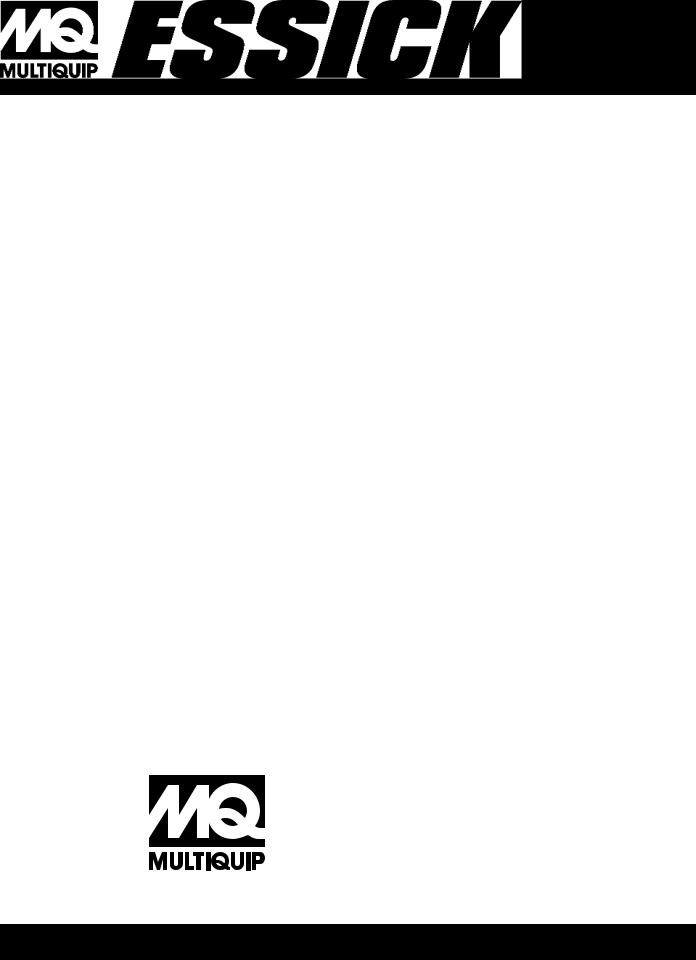
PARTS AND OPERATION MANUAL
© COPYRIGHT 2001, MULTIQUIP INC.
FM9
FINISHING MACHINE
Revision #1 (03/12/01)
MULTIQUIP INC. |
PARTS DEPARTMENT: |
18910 WILMINGTON AVE. |
800-427-1244 |
CARSON, CALIFORNIA 90746 |
FAX: 800-672-7877 |
310-537-3700 |
SERVICE DEPARTMENT: |
800-421-1244 |
800-478-1244 |
FAX:310-537-3927 |
FAX:310-537-4259 |
E-mail:mq@multiquip.com • www:multiquip.com
Atlanta • Boise • Dallas • Houston • Newark Montreal, Canada • Manchester, UK
Rio De Janiero, Brazil • Guadalajara, Mexico
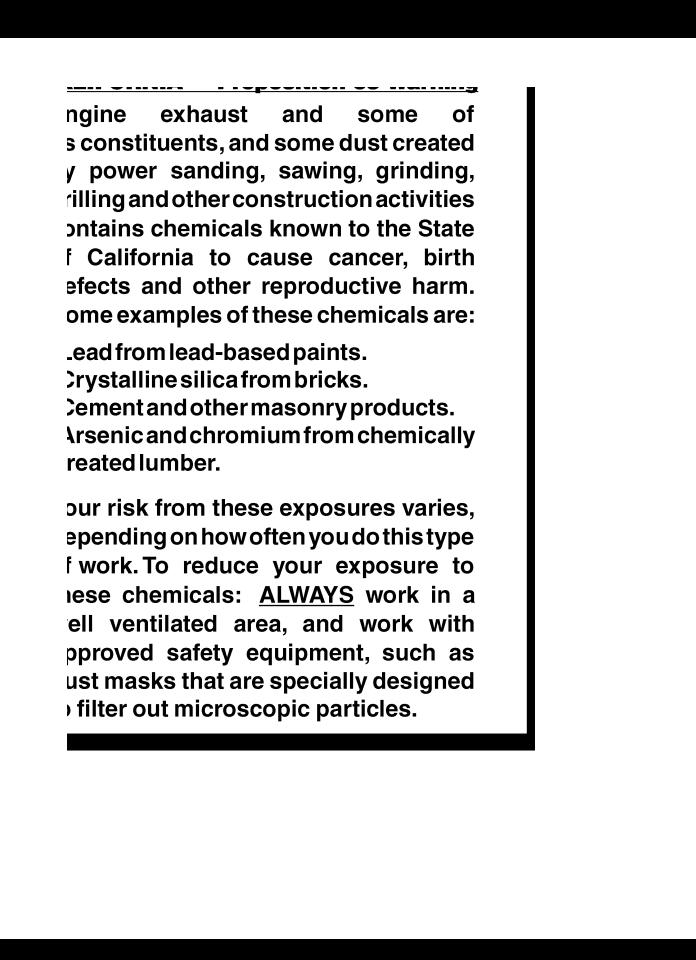
PAGE 2 — ESSICK FM9 — PARTS & OPERATION MANUAL — REV. #1 (03/12/01)
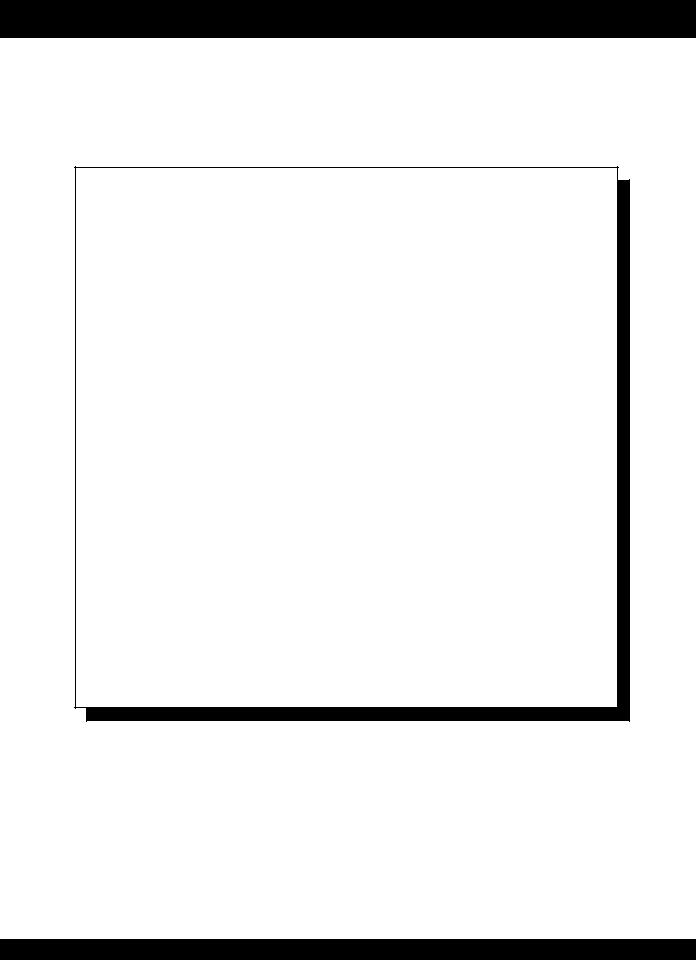
HERE'S HOW TO GET HELP
PLEASE HAVE THE MODEL AND SERIAL NUMBER ON-HAND WHEN CALLING
PARTS DEPARTMENT
800-427-1244 or 310-537-3700 FAX: 800-672-7877 or 310-637-3284
SERVICE DEPARTMENT/TECHNICAL ASSISTANCE
800-478-1244 or 310-537-3700 FAX: 310- 537-4259
WARRANTY DEPARTMENT
888-661-4279, or 310-661-4279 FAX: 310- 537-1173
MAIN
800-421-1244 or 310-537-3700 FAX: 310-537-3927
ESSICK FM9 — PARTS & OPERATION MANUAL — REV. #1 (03/12/01) — PAGE 3

TABLE OF CONTENTS
Here's How to Get Help .......................................... |
3 |
Table Of Contents ................................................... |
4 |
Parts Ordering Procedures ..................................... |
5 |
Rules For Safe Operation ....................................... |
6 |
ESSICK — FM-9 |
|
Operations ......................................................... |
7-12 |
Specifications ........................................................ |
13 |
Explanation Of Codes In Remarks Column .......... |
14 |
Suggested Spare Parts ......................................... |
15 |
Cab Assembly .................................................. |
16-17 |
Automatic Clutch Assembly ............................. |
18-19 |
Transmission Assembly.................................... |
20-21 |
Transmission Assembly.................................... |
22-23 |
Browning Nozzle .............................................. |
24-25 |
Finishing Nozzle ............................................... |
26-27 |
Terms and Conditions Of Sale — Parts ................ |
28 |
NOTE: Specification and part number are subject to change without notice.
PAGE 4 — ESSICK FM9 — PARTS & OPERATION MANUAL — REV. #1 (03/12/01)
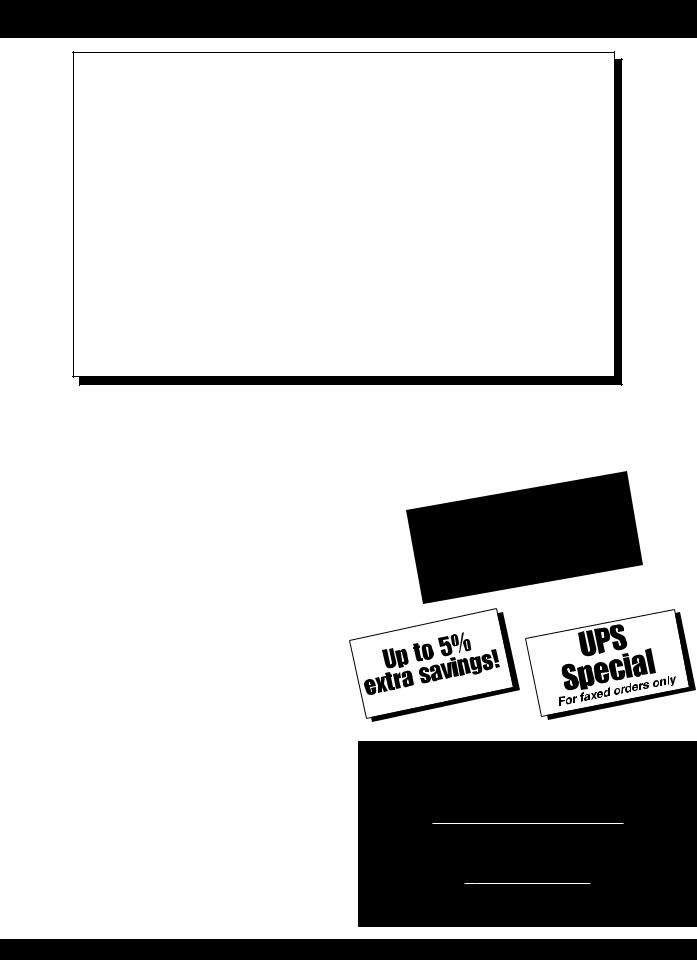
PARTS ORDERING PROCEDURES
nDealer account number
nDealer name and address
nShipping address (if different than billing address)
nReturn fax number
nApplicable model number
nQuantity, part number and description of each part
nSpecify preferred method of shipment:
•UPS Ground
•UPS Second Day or Third Day*
•UPS Next Day*
•Federal Express Priority One (please provide us with your Federal Express account number)*
•Airborne Express*
•Truck or parcel post
*Normally shipped the same day the order is received, if prior to 2PM west coast time.
Earn Extra Discounts when you order by FAX!
All parts orders which include complete part numbers and are received by fax qualify for the following extra discounts:
Number of |
|
line items ordered |
Additional Discount |
1-9 items |
3% |
10+ items** |
5% |
Get special freight allowances when you order 10 or more line items via FAX!**
nUPS Ground Service at no charge for freight
nPS Third Day Service at one-half of actual freight cost
No other allowances on freight shipped by any other carrier.
**Common nuts, bolts and washers (all items under $1.00 list price) do not count towards the 10+ line items.
*DISCOUNTS ARE SUBJECT TO CHANGE*
Fax order discount and UPS special programs revised June 1, 1995
Extra |
Fax |
Discount |
||||
|
|
USA |
||||
|
|
|
||||
for |
Domestic |
|
||||
Dealers |
Only |
|||||
|
||||||
|
|
|
||||
Now! Direct TOLL-FREE access to our Parts Department!
Toll-free nationwide:
800-421-1244
Toll-free FAX:
800/6-PARTS-7 • 800-672-7877
ESSICK FM9 — PARTS & OPERATION MANUAL — REV. #1 (03/12/01) — PAGE 5
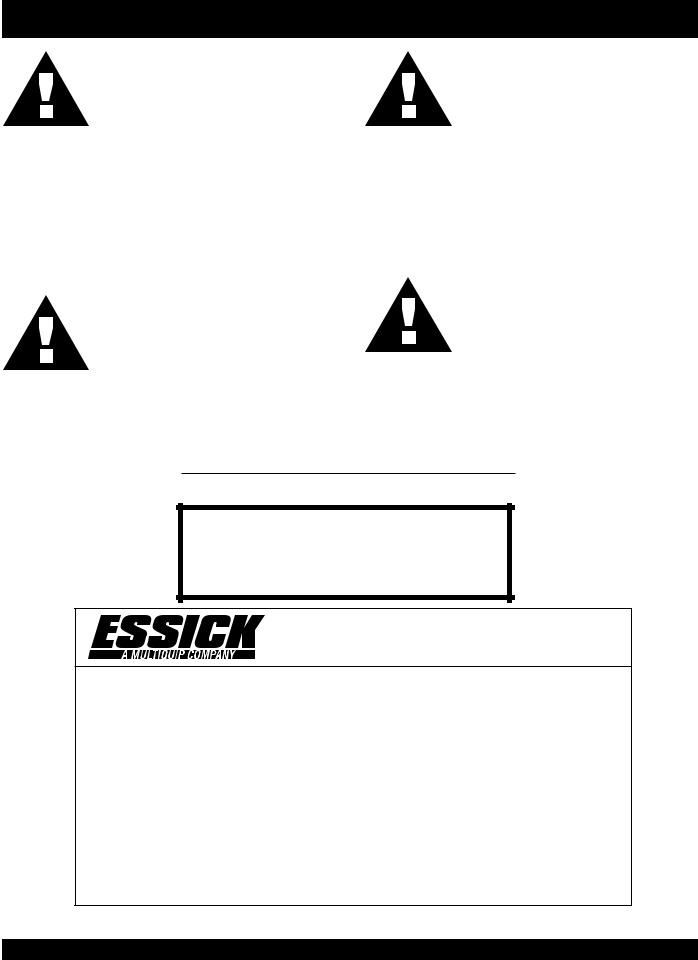
RULES FOR SAFE OPERATION
■Do not operate or service this equipment before reading the operating and maintenance instructions manual or serious injury may result.
■Do not operate this equipment unless all guards and safety devices are attached and in place.
■Stop the engine when leaving the equipment.
■Block the unit when leaving or when using on a slope
■Maintain this equipment in a safe operating condition at all times.
■Caution must be exercised while servicing this equipment. Rotating and moving parts can cause injury if contacted.
■Stop the engine before servicing, adding fuel and oil.
■When towing, an adequate safety chain must be fastened to the frame.
■Keep all inexperienced and unauthorized people away from the equipment at all times.
■Unauthorized equipment modifications will void all warranties.
■Check all fasteners periodically for tightness. Also check towing tongue bolt, lock nut and wheel lug nuts for wear.
■Wear safety glasses at all times when working around machinery.
■Stop the engine and disconnect the spark plug before allowing anybody’s hands in the mixing drum.
■Never pour or spray water over the engine or electric motor.
■Always stand clear of dump handle when mixer is in operation. Any binding of material between the mixer blades and drum will cause drum and handle to quickly move in the discharge position.
The safety instruction decals shown must be on all Essick Mixers
CAUTION!
SHUT OFF ENGINE BEFORE PUTTING HANDS IN MIXING DRUM
Caution Decal is P/N FM???????
SAFETY INSTRUCTIONS
1.Do not operate or service this machine before reading the operating and maintenance manual.
2.Keep all inexperienced and/or unauthorized people away from equipment at all times.
3.Do not operate this equipment unless all guards and safety devices are attached and in place.
4.Keep this equipment in safe operating condition at all times.
5.Caution must be exercised while servicing this equipment.
Rotating and moving parts can cause injury if contacted.
6.Stop engine and allow to cool before adding fuel or oil.
7.Stop engine when leaving equipment.
8.Block unit when parking on a slope.
9.Unauthorized equipment modifications will void all warranties.
ESSICK CONSTRUCTION PRODUCTS — A MULTIQUIP COMPANY — CARSON, CALIFORNIA
The safety instruction decal is P/N FM???????????
PAGE 6 — ESSICK FM9 — PARTS & OPERATION MANUAL — REV. #1 (03/12/01)

SAFETY
1.Do not operate or service this equipment before reading the operating and maintenance instruction manual.
2.Do not operate this equipment unless all guards and safety devices are attached and in place.
3.Stop engine when leaving equipment.
4.Block unit when parking on a slope.
5.Maintain this equipment in safe operating condition at all times.
6.Caution must be exercised while servicing this equipment. Rotating and moving parts can cause injury if contacted.
7.Stop engine before adding fuel or oil. Never spray water over the engine or electrical motor.
8.Keep all inexperienced and unauthorized people away from equipment at all times.
9.Unauthorized equipment modifications will void all warranties.
10.Run transmission in reverse gear to relieve back pressure before disconnecting gun or hoses.
11.Screen must be on hopper at all times machine is in operation.
12.Stop engine before putting hands in hopper.
13.Wear safety eye glasses at all times when working around machine or material lines.
14.Electrical operated machines refer to supplemental FM5E- I safety/operating instructions
GENERAL
The essick model FM9 plastering machine is in a class by itself. Its main functions are that of a standard finishing machine: Mainly applying acoustical ceilings, exterior dash stucco finish and inside sand finish, as well as fireproofing steel beams. Although it was not designed to be used in place of a high-volume base coat plastering machine, it may be used to apply inside brown and it is capable of applying a half-sand, half-vermiculite mix at a very practical rate, which is satisfactory for some jobs.
This machine is equipped with a transmission having 3 forward speeds plus a reverse gear and is powered by a 9.2 hp engine, which also drives a heavy-duty twin-cylinder air compressor.
Although the procedure for mixing and applying the materials varies with each material being sprayed, the following procedure applies to all the materials mentioned above.
FM-9 — OPERATIONS
OPERATING INSTRUCTIONS
Connect the air lines from the machine to the air control block mounted on the nozzle. One air line runs from the air compressor outlet on the machine to the inlet on the control block next to the sleeve valve. This line has air blowing out of it when the compressor is running. The other air line runs from the sleeve valve on the control block to the throttle cylinder inlet on the machine.
In operation, the compressor furnishes air to the control block. The valve located on the front of the block is for the adjustment of atomized air which is used for the spraying of material.The sleeve valve operates the throttle cylinder on the engine. When the sleeve valve is in the closed position, air pressure is applied to the cylinder and the engine will speed up to the preset governed speed. When the sleeve valve is in the open position, air pressure is released from the spring loaded throttle cylinder and the engine will return to idle speed.
Before starting engine, check oil levels in engine crankcase, transmission and compressor. Place volume control lever (transmission lever) in the position for the desired speed to be used.Turn the throttle control air valve, located on the spray gun, to the “off position.
After mixing the material, lubricate the pump and hose by pouring a few gallons of water into the hopper. Adjust the air pressure to approximately 20 lbs. and turn the throttle control air valve to “on” position.
Continue to pump out the water until it reaches the level of the pump.Then fill the hopper half full with the material to be sprayed. After the remaining water in the hose has been pumped out and material appears at the nozzle, point nozzle into hopper and make final air adjustments. With final adjustments made, turn air valve off.
CAUTION: Never turn off pump until material appears at nozzle. This may cause separation of the material, which would clog up pump and hose.
Fill hopper and carry nozzle and hose to spraying area.Turn air valve”on”and proceed to spray, working a pattern.Always overlap the spray, but never hold the gun still in an attempt to fill a void or defect.
CAUTION: Never run the pump dry, as this causes rapid pump wear or damage.
ESSICK FM9 — PARTS & OPERATION MANUAL — REV. #1 (03/12/01) — PAGE 7

CLEANING OF MACHINE
At the end of the day, or when changing from one material to another, the machine should be washed out. It is also suggested that when pumping quick setting materials to wash out machine and hoses approximately every 4 hours.
To clean the hopper and pump parts, run transmission in reverse gear to relieve back pressure in hose, turn off engine, remove spray gun and disconnect material hose. Remove pipe plug at bottom of hopper, drain, and wash down the remaining material with water. Replace plug.
After the material has been washed out of the hopper, the hose can be cleaned by disconnecting the material hose from the machine and removing the spray gun. Roll up a wet sponge and place it into the material hose, reconnect the hose to pump fitting, fill hopper half full with water and start machine.Pump enough water through hose to push sponge through entire length of hose. After sponge is pumped out, turn off engine and remove drain plug from hopper to drain remaining water. Repeat the sponge process if necessary.
Wash out spray gun, nozzle and orifices. Hose down screens and the outside of the machine.
Note: When washing down the outside of the machine, be sure the rubber boot is in place over the transmission lever pivot. This prevents water from entering the transmission. Clean and oil all threads and joints.
MIXING AND APPLYINGVARIOUS MATERIAL
EXTERIOR DASH STUCCO
In areas where this type of finish is popular, a prepared machine mix is available which requires only the addition of water. however, some contractors prefer to mix their own material.The following is considered a very satisfactory machine mix:
200 lbs. — Silica sand mo. 20
50 to 60 lbs. — Hydrated lime
100 lbs. — Plastic cement
2 to 3 lbs. — Zonolite finish aggregate
Color may be added as desired, but should be measured for uniformity.
The above materials must be thoroughly mixed and of a thin consistency, similar to a hand dash coat mix.
FM-9 — OPERATIONS
The surface to be sprayed should be thoroughly dry. Do not wet before applying dash coat. Use either a 1/4" or 3/8" orifice. Be sure a soft rubber stator tube is used, as soft rubber will resist abrasives. After material is mixed, proceed as explained in the operating instructions. Adjust volume at low speed and air pressure to 20-25 lbs. If a second coat is to be applied, be sure that the surface appears dry to the eye before application or it will dry spotty and show a different shade of color.
SIMULATED ACOUSTIC CEILINGS
In many areas prepared materials are available for simulated acoustic ceilings. In areas where prepared materials are not available and where a contractor prefers to mix his own, the following mix makes a satisfactory texture.
100 lbs. — Gypsum
6 cu. ft. —Vermiculite or perlite
Mix the above materials thoroughly so the aggregate does not separate when in hopper. This mix should be of heavier consistency than exterior dash, but still wet enough to pass through a 3/8" screen.
If the material aggregate is made of vermiculite, use the hard rubber stator. If the material is made of perlite, the soft rubber stator should be installed. By using a 3/8" orifice and adjusting the volume at second speed and the air pressure to 20-25 lbs. A very satisfactory pattern can be obtained.
Since the finished appearance depends on the condition of the original surface, it is suggested that any obvious defects, such as ridges or holes, should be repaired with a hand trowel also, the ceiling should BE scraped with a floor or wall scraper prior to spraying the first coat.
Care should be taken when spraying the ceilings to fill the angles well. This can be achieved by pointing the nozzle directly into the angle, thereby spraying on the wall as well as on the ceiling. The overspray on the wall can be quickly removed by using the same scraper mentioned above.
You will find that a better job can be accomplished if two coats are applied. But before applying the second coat, an inspection of the surface should be made and any defects should be repaired with a small trowel. After the inspection, the second coat can be immediately applied.
PAGE 8 — ESSICK FM9 — PARTS & OPERATION MANUAL — REV. #1 (03/12/01)

FULL ACOUSTIC CEILINGS AND FIREPROOFING UNDER STEEL DECK
There are a number of various acoustic materials available, all of which can be pumped through this machine. Some of these materials are made from vermiculite and others from perlite. Although we do not make any recommendations as to which is the better acoustic material, we do point out the fact that perlite is very abrasive and will cause rapid pump wear whereas, vermiculite will give longer pump life.
Only water needs to be added to ready-prepared materials. Some manufacturers suggest the correct amount of water in the instructions on the bag. However, if no instructions are available, the material should be mixed to a consistency thinner than. that of a mixture for hand application. I.E., thin enough so that only about i0 percent of the material will be retained on a 1/2" screen when it is poured into the hopper of the machine.
After the material is mixed, proceed as explained in the operating instructions. Use either a 3/8", 7/16" or 1/2" orifice, depending on the desired texture. Use the same size hopper screen as the size of the orifice that is going to be used. Use 3/8" screen with 7/16" orifice. Use a hard rubber stator with vermiculite and a soft rubber stator with perlite. By adjusting the volume to second speed and the air pressure to 15-20 lbs, a good yardage can be obtained in small areas. However, in larger areas it may be desirable to operate at full volume.
The application of full acoustic is very similar to that of simulated acoustic, except that successive coats can be applied until proper thickness is obtained. For application procedure refer to “simulated acoustic ceilings” paragraph.
FIREPROOFING STEEL BEAMS
Consult the building specifications regarding the type of material to be used. Normally, for fireproofing metal lath wrapped steel beams, the mixture consists of one sack of either perlite or vermiculite and one sack of gypsum.These materials should be mixed to a consistency thinner than that for hand application and sprayed approximately 1" thick with an application. If a greater volume is desired, it is recommended to use a 1-1/2" hose with the machine at full volume. Note:The shorter the hose length, the greater the volume obtained.
Use the hard rubber stator with vermiculite and the soft rubber stator with perlite. It is also suggested that the largest size air jet be used in the nozzle and a 7/16" or 1/2" orifice. With the air pressure at minimum (approximately 10 PSI).
This is a very difficult operation and the operator’s technique will improve with experience.The majority of experienced operators prefer to use a short nozzle for better maneuvering around steel beams.
FM-9 — OPERATIONS
DRYWALL MIX APPLICATION
The FM9 works quite satisfactorily for applying drywall texture mixes such as: Spatter, orange peel, fog, sand finish, as well as simulated acoustic textures. In addition, it can be used for application of mastics, sealants, emulsions, glazes, roofingfinishes, sealers, water base paints, and cement paints.
BROWN COAT
As previously stated, the ESSICK MODEL FM9 plastering machine is not designed to do the work of a large base coat machine. Although it is not recommended, due to the rapid wear on the rotor and stator tube, it can apply brown coat and scratch material at a rate fast enough to be practical for some jobs.
When the machine is to be used for the application of brown or scratch material we recommend that the following suggestions be taken into consideration to aid the machine in pumping and also to obtain better results.
Install on machine, if not presently equipped, a soft rubber stator, a “hi volume” rotor and a 1-1/2" pump outlet fitting. Refer to “hi volume” instructions for changing of rotor and stator.
Use, if possible, a 400675 browning nozzle with a 5/8" orifice for outside brown and scratch and a 1/2" orifice for inside brown. The length of 1-1/2" hose should not exceed 100 ft. With hoses and nozzle attached adjust the air pressure to approximately 20 p.s.i. and set machine at full volume.
The following is a satisfactory brown coat mix:
1-1/2 cu.ft. —Vermiculite
1-1/2 cu. ft. — Sand
1 Sack gypsum
Note:The best results are obtained by not using over 50 percent sand aggregate.
The mixing procedure should be as follows: Put approximately 10 gallons of water in the mixer and add 1-1/2 cu. ft.of vermiculite. This allows the vermiculite to absorb sufficient water. Add one sack of gypsum (machine application type) and shovel in 1-1/2 cu. ft. of sand (approximately eleven no. 2 shovels). additional water should be added at this time.
It is difficult to predetermine the amount of water, as there are several variations possible. The amount of water is critical and experience will allow the operator to deterhine the correct amount.
ESSICK FM9 — PARTS & OPERATION MANUAL — REV. #1 (03/12/01) — PAGE 9
